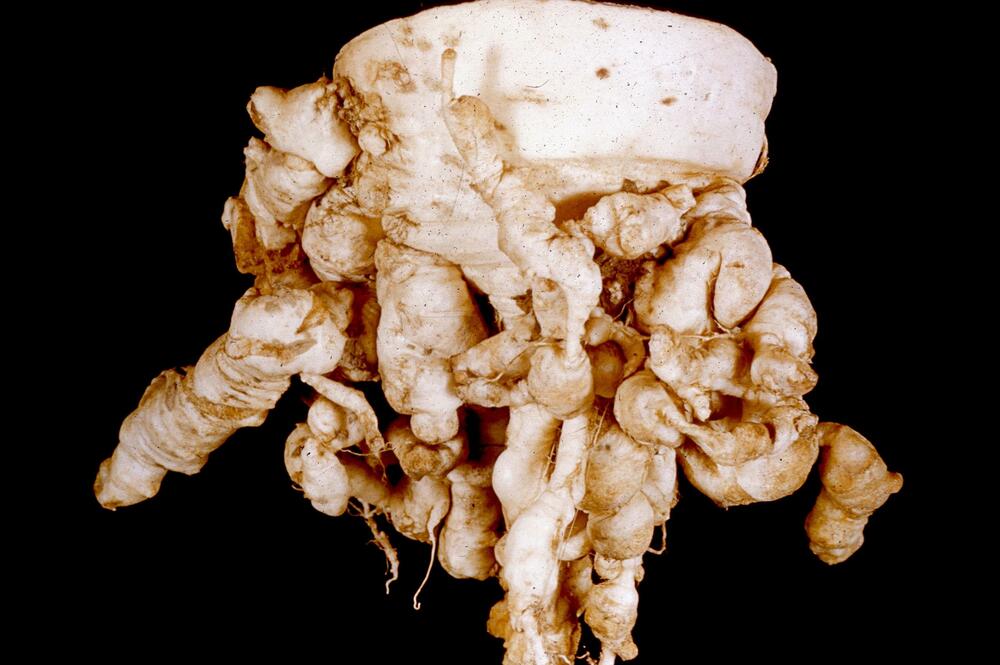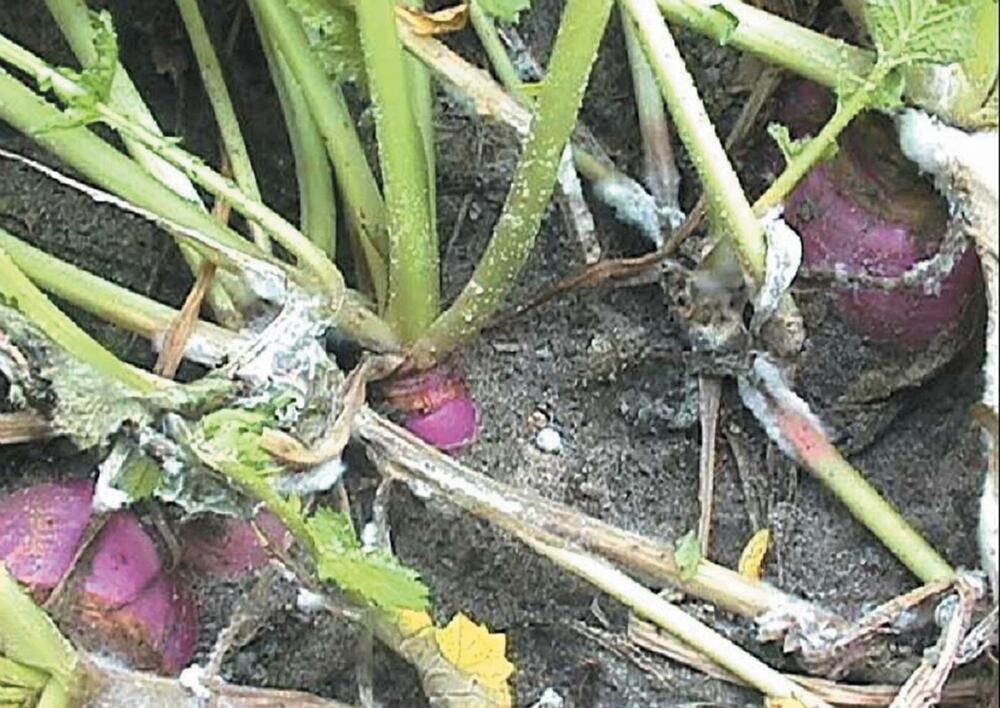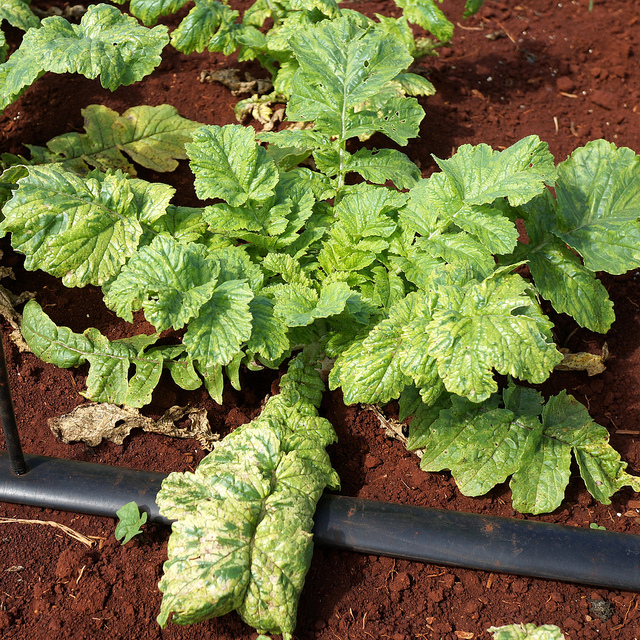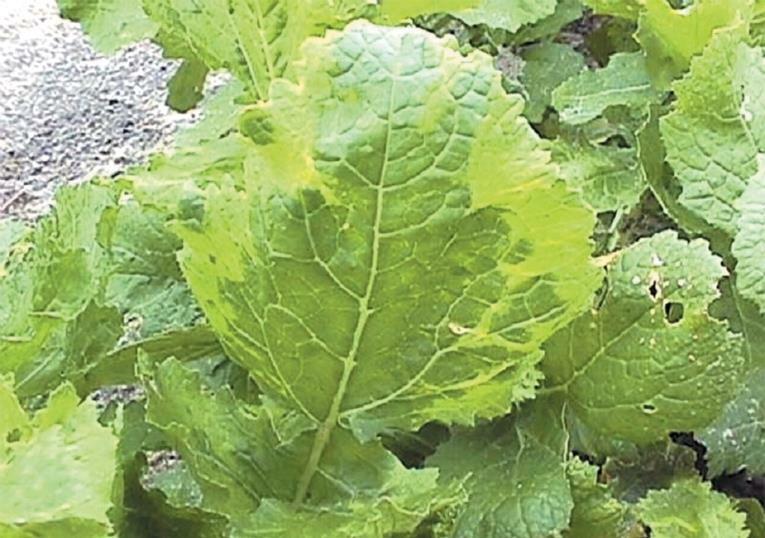Turnip
Content
Content
Description
Uses
Propagation
References
Common Pests and Diseases
Diseases
Category : Fungal
Alternaria leaf spot (Black spot, Gray spot) Alternaria spp.
Symptoms
Small dark spots on leaves which turn brown to gray; lesions may be round or angular and may possess a purple-black margin; lesions may form concentric rings, become brittle and crack in center; dark brown elongated lesions may develop on stems and petioles
Cause
Fungus
Comments
May become a problem during cool, wet periods
Management
Plant only pathogen-free seed; rotate crops; applications of appropriate fungicides control disease when presentAnthracnose Colletotrichum higginisianum
Symptoms
Small circular or irregularly shaped dry spots which are gray to straw in color on leaves; a high number of spots may cause the leaf to die; lesions may coalesce to form large necrotic patches causing leaves to turn yellow and wilt; lesions may split or crack in dry centers; dry sunken spots on roots which enlarge and turn gray or brown
Cause
Fungus
Comments
Fungus overwinters on leaf debris and on related weeds; disease emergence is favored by moist, warm conditions
Management
Control of disease depends on sanitary practices; treat seeds with hot water prior to planting; rotate crops; plant in an area with good soil drainage; remove all cruciferous weeds which may act as a reservoir for the fungusBlack root Aphanomyces raphari
Symptoms
Small black-blue areas on roots which expand and girdle taproot; roots become constricted at site of lesions; black discoloration extends into root
Cause
Fungus
Comments
Fungus can survive in soil for prolonged periods
Management
Control depends on crop rotation with non-brassica speciesBlack rot Xanthomonas campestris
Symptoms
Seedlings develop wilted yellow to brown leaves and collapse; yellow, V-shaped lesions on mature leaf margins; dark rings can be found in the cross section of the stem
Cause
Bacterium
Comments
Disease emergence favors warm, wet conditions
Management
Primary control methods based on good sanitation; plant disease-free seed; rotate crops every 2 years or less to non-brassica; avoid sprinkler irrigationCercospora leaf spot (Frogeye leaf spot) Cercospora brassicicola
Symptoms
Angular or circular green to gray spots with brown borders on leaves; plant defoliation may occur in the case of a severe infestation
Cause
Fungus
Comments
Disease emergence favors cool temperatures and wet weather
Management
Plant only certified disease-free seed; avoid overhead irrigation; rotate crops to non-brassica species for 2-3 years; apply appropriate fungicide if disease emergesClubroot Plasmodiophora brassicae
Symptoms
Slow growing, stunted plants; yellowish leaves which wilt during day and rejuvenate in part at night; swollen, distorted roots; extensive gall formation
Cause
Fungus
Comments
Can be difficult to distinguish from nematode damage; fungus can survive in soil for periods in excess of 10 years; can be spread by movement of contaminated soil and irrigation water to uninfected areas
Management
Once the pathogen is present in the soil it can survive for many years, elimination of the pathogen is economically unfeasible; rotating crops generally does not provide effective control; plant only certified seed and avoid field grown transplants unless produced in a fumigated bed; applying lime to the soil can reduce fungus sporulationDowny mildew Peronospora parasitica
Symptoms
Irregular yellow patches on leaves which turn light brown in color; fluffy gray growth on the undersides of the leaves
Cause
Fungus
Comments
Disease emergence favors cool temperatures; disease spreads quickly in wet conditions
Management
Remove all crop debris after harvest; rotate with non-brassicas; application of appropriate fungicides may be required if symptoms of disease are presentSclerotinia rot (White mold) Sclerotinia sclerotiorum
Symptoms
Irregular, necrotic gray lesions on leaves; white-gray leions on stems; reduced pod set; shattering seed pods
Cause
Fungus
Comments
Disease emergence favors moderate to cool temperatures and high humidity
Management
Rotate crop to non-hosts (e.g. cereals) for at least 3 years; control weeds; avoid dense growth by planting in adequately spaced rows; apply appropriate foliar fungicidesWhite spot Pseudocercosporella capsellae
Symptoms
Small, necrotic, brown spots on leaf tips or margins that matures to light gray or white with the original dark spot in center; margins of lesions may be darker; lesions may coalesce to form large chlorotic areas and cause defoliation
Cause
Fungus
Comments
Disease emergence favors cool and wet conditions
Management
No known plant resistance to white leaf spot so control relies on cultural practices such as rotating crops and removing weeds; application of appropriate fungicide may help control the diseaseWirestem (Damping-off) Rhizoctonia solani
Symptoms
Death of seedlings after germination; brown-red or black rot girdling stem; seedling may remain upright but stem is constricted and twisted (wirestem)
Cause
Fungus
Comments
Disease emergence favors cool, wet soils
Management
Plant pathogen-free seed or transplants that have been produced in sterilized soil; apply fungicide to seed to kill off any fungi; shallow plant seeds or delay planting until soil warmsCategory : Viral
Turnip mosaic Turnip mosaic virus (TuMV)
Symptoms
Yellow and green mosaic patterns on leaves; necrotic areas on leaves; veinclearing and chlorosis may occur in older leaves; black spots and brown necrotic streaks on stems; stunted plant growth ond reduced yield
Cause
Virus
Comments
Transmitted by many species of aphid, including cabbage aphids and peach aphids
Management
Use of reflective mulches may help to deter aphid feeding; applications of appropriate insecticides may reduce secondary spread of virusPests
Category : Insects
Cabbage aphid Brevicoryne brassicaea
Symptoms
Large populations can cause stunted growth or even plant death; insects may be visible on the plant leaves and are small, grey-green in color and soft bodied and are covered with a white waxy coating; prefer to feed deep down in cabbage head and may be obscured by the leaves
Cause
Insect
Comments
Cabbage aphids feed only on cruciferous plants but may survive on related weed species
Management
If aphid population is limited to just a few leaves or shoots then the infestation can be pruned out to provide control; check transplants for aphids before planting; use tolerant varieties if available; reflective mulches such as silver colored plastic can deter aphids from feeding on plants; sturdy plants can be sprayed with a strong jet of water to knock aphids from leaves; insecticides are generally only required to treat aphids if the infestation is very high - plants generally tolerate low and medium level infestation; insecticidal soaps or oils such as neem or canola oil are usually the best method of control; always check the labels of the products for specific usage guidelines prior to useFlea beetles Phyllotreta spp.
Symptoms
Small holes or pits in leaves that give the foliage a characteristic “shothole” appearance; young plants and seedlings are particularly susceptible; plant growth may be reduced; if damage is severe the plant may be killed; the pest responsible for the damage is a small (1.5–3.0 mm) dark colored beetle which jumps when disturbed; the beetles are often shiny in appearance
Cause
Insects
Comments
Younger plants are more susceptible to flea beetle damage than older ones; older plants can tolerate infestation; flea beetles may overwinter on nearby weed species, in plant debris or in the soil; insects may go through a second or third generation in one year
Management
In areas where flea beetles are a problem, floating row covers may have to be used prior to the emergence of the beetles to provide a physical barrier to protect young plants; plant seeds early to allow establishment before the beetles become a problem - mature plants are less susceptible to damage; trap crops may provide a measure of control - cruciferous plants are best; application of a thick layer of mulch may help prevent beetles reaching surface; application on diamotecoeus earth or oils such as neem oil are effective control methods for organic growers; application of insecticides containing carbaryl, spinosad, bifenthrin and permethrin can provide adequate control of beetles for up to a week but will need reappliedRoot maggots Delia spp.
Symptoms
Scars and feeding tunnels on surface of turnip; root damage may be extensive; larvae are white or white-yellow in color, reach approx. 1 cm (0.3 in) in length and taper towards the head; adult insect is a small fly which resembles a housefly
Cause
Insect
Comments
Root maggots will attack all varieties of crucuferous plants; insect overwinters as pupae in the soil
Management
If root maggots were problematic, avoid planting root crops in same area the following year; if crops are too badly damaged to harvest remove and destroy all crop debris; use of floating row covers can dramatically reduce damage to crops by preventing female flies from laying eggs - note, row covers only effective where root maggots are not already present; there are currently no pesticides registered for use on root maggots in the home garden in the USA
Wireworms
Aeolus spp.
Anchastus spp.
Melanotus spp.
Limonius spp
Symptoms
Death of seedlings; reduced stand; girdled stems and white heads; wireworm larvae can be found in soil when dug round the stem; larvae are yellow-brown, thin worms with shiny skin
Cause
Insect
Comments
Larval stage can last between 1 and 5 years depending on species























